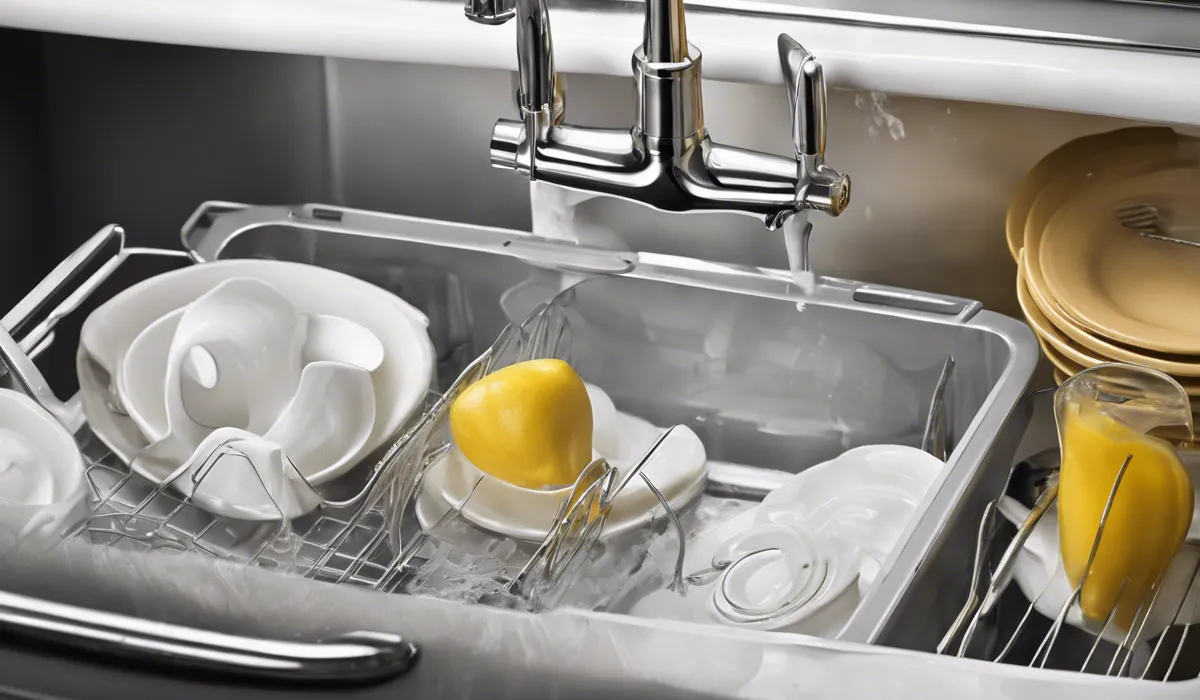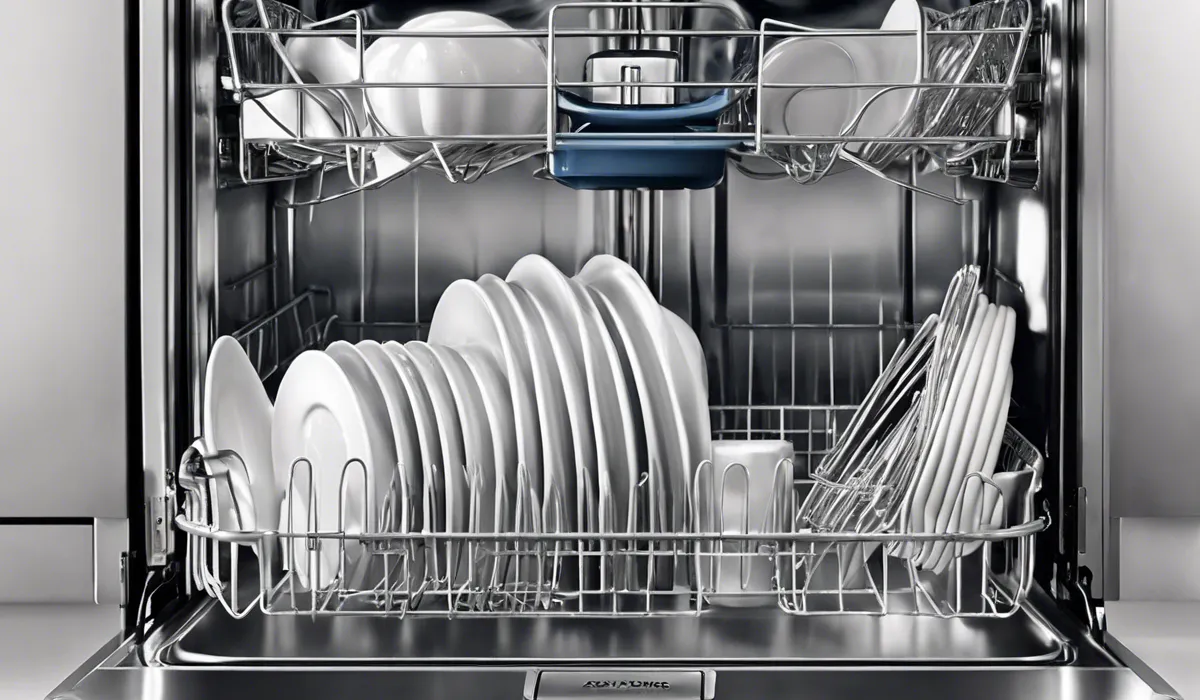How to Wash Dishes in Dishwasher: A Sparkling Guide
To wash dishes in a dishwasher, scrape off food residue, load the machine with items facing the spray arms, add the appropriate detergent, choose a cycle, and start the machine. Ensure not to overcrowd and arrange utensils properly for optimal cleaning.
Preparing Your Dishes for the Dishwasher

Scrape Off Food Remnants
Before placing your dishes into the dishwasher, make sure to remove large pieces of food.
This step is crucial as it prevents the filter from clogging and ensures that water and detergent can reach every part of your dishes. Simply use a spatula or a paper towel to wipe away leftovers into the trash or compost bin.
Pre-Rinse Dishes If Necessary
If you notice food that is stuck on or dishes are heavily soiled, a quick pre-rinse under warm water can make a big difference.
This helps to loosen up the grime, making it easier for your dishwasher to do its job effectively. However, if you have a high-performance dishwasher, you may skip this step.
Checking and Emptying the Garbage Disposal
Your dishwasher and garbage disposal often share the same drain, so ensure that the garbage disposal is clear to prevent water from backing up into the dishwasher. Run the disposal with water for a few seconds to make sure it’s clear.
Loading Sharp Objects Safely
Knives and other sharp utensils should be loaded with the sharp end pointing down. This not only protects you from getting cut when unloading but also allows for better cleaning and prevents damage to the dishwasher’s racks.
Placing Dishes Strategically for Optimal Cleaning
Position your dishes so that they are facing the center of the dishwasher, allowing the spray arms to reach every surface. Be mindful not to block the detergent dispenser with large items, as this can hinder the release of the detergent.
Loading the Dishwasher Properly

Utilizing Racks and Their Designated Roles
Understand the layout of your dishwasher; the bottom rack is typically for plates, pans, and casseroles, while the top rack is for glasses, cups, and less soiled items.
Use the silverware basket for utensils, making sure not to nest spoons or forks together.
Positioning Dishes for Maximum Water Exposure
Angle bowls and cups so the open end faces down, allowing water to run off them and not pool. Plates should be loaded vertically and spaced apart to let the water and detergent circulate properly.
Balancing the Load to Avoid Glassware Damage
Place fragile items like glasses and stemware securely in the top rack. Ensure they are not touching each other to prevent breakage.
Use plastic items in the top rack as well, since the heating element is in the bottom and could cause melting.
Ensuring Spinning Arms Can Move Freely
Before starting the dishwasher, spin the spray arms to ensure they can move without hitting any dishes. If they are obstructed, rearrange your dishes. This guarantees that water can reach all your dishes for a thorough clean.
Avoiding Overcrowding to Improve Cleaning Efficiency
While it might be tempting to fit as many dishes as possible, overcrowding can lead to poor cleaning results. Water and detergent need space to circulate, so ensure each item has enough room around it for an effective wash.
Using Detergent and Running the Dishwasher

Choosing the Right Detergent
There are various detergents available, including powders, liquids, and pods.
Consider the hardness of your water and the type of dishwasher when selecting your detergent. Some detergents are specially formulated for hard water or for use with specific dishwasher models.
Filling the Detergent Dispenser Correctly
Read the instructions on the detergent packaging to determine the correct amount needed for your load size. Overfilling can lead to residue on dishes, while underfilling might not clean them properly.
Selecting the Appropriate Wash Cycle
Choose a wash cycle that matches the soil level of your dishes. For everyday loads, a normal cycle is sufficient.
owever, for heavily soiled items or if you’re environmentally conscious, select an appropriate cycle such as ‘Heavy’ for more cleaning power or ‘Eco’ to save water and energy.
Adding Rinse Aid for Spotless Drying
Rinse aid helps to remove water from your dishes more effectively during the final rinse, preventing water spots.
Fill the rinse aid dispenser according to the manufacturer’s instructions, and adjust the settings based on the hardness of your water for best results.
Starting the Dishwasher and Monitoring Its Performance
Once your dishwasher is loaded and detergent is added, close the door securely and select your desired cycle.
Press start and let the dishwasher run its course. It’s a good practice to occasionally check on its performance to ensure everything is functioning correctly.
FAQs About Washing Dishes in a Dishwasher
How do I prepare dishes for washing in a dishwasher?
Scrape off food residue from the dishes before loading them into the dishwasher to prepare for washing.
What is the correct way to load dishes in a dishwasher?
Load dishes with items facing the spray arms, ensuring that they are not overcrowded and are arranged properly for optimal cleaning.
How much detergent should I use in a dishwasher?
Add the appropriate amount of detergent as recommended by the detergent manufacturer and your dishwasher’s guidelines.
Which cycle should I choose on my dishwasher?
Choose a cycle that is suitable for the type of dishes being washed and the level of soil; common cycles include normal, eco, and heavy.
What should I avoid placing in the dishwasher?
Avoid placing items that are not dishwasher-safe, such as certain plastics, delicate glassware, and hand-painted ceramics in the dishwasher.
Final Thoughts
Proper dishwashing in a dishwasher involves scraping off food remnants before loading. Items should face the spray arms and not be overcrowded to allow thorough cleaning.
Utilizing the correct detergent and selecting an appropriate cycle are crucial steps. Proper arrangement of utensils ensures optimal cleaning efficiency for sparkling results.






